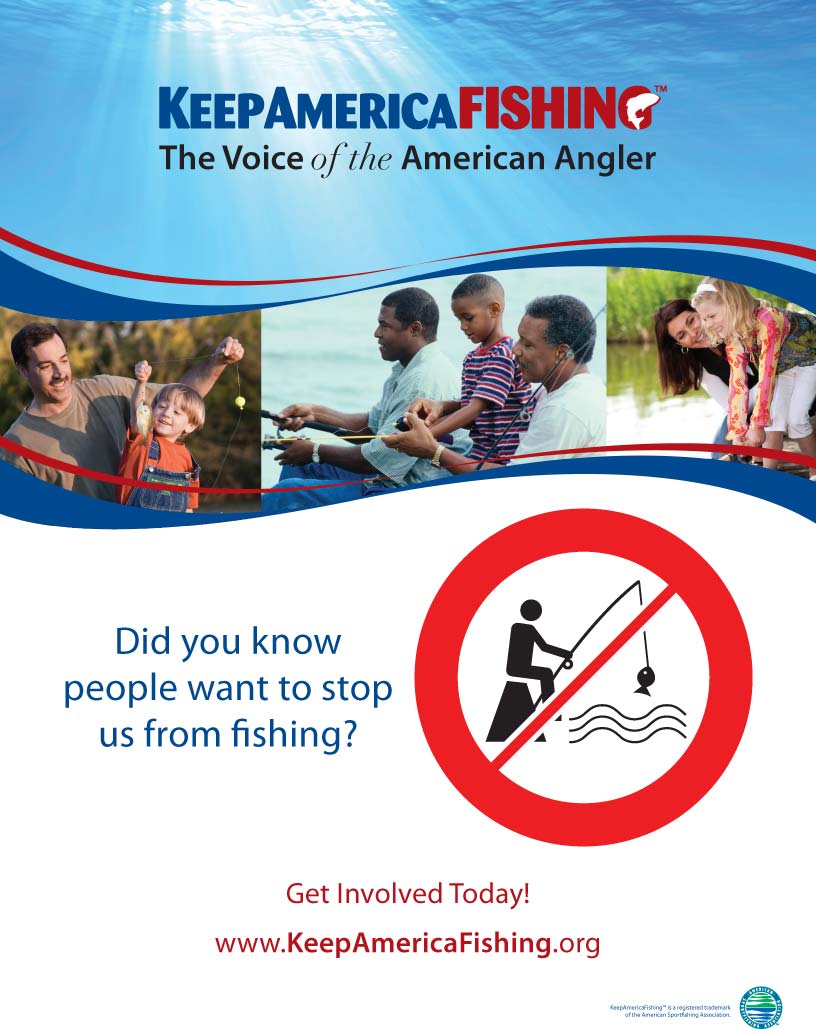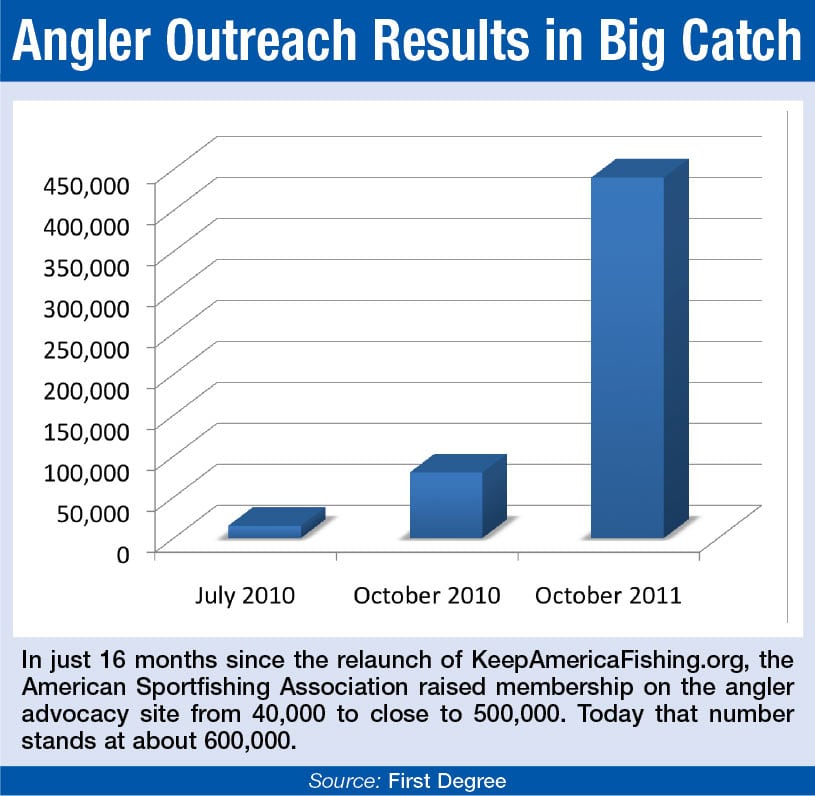 |
| Initially representing the sportfishing industry, in 2010 the American Sportfishing Association began attracting anglers via partnerships, media outreach and PSAs. Image courtesy of First Degree |
Organization: American Sportfishing Association
Agency: First Degree
Timeframe: March 2010 - Present
For most trade associations, the main objective is to ably represent their member industries through strong lobbying and communication of key issues. But the following is a case of a trade association going one step further, successfully reaching through an advocacy campaign the customers who purchase its members’ fishing products and services—upping membership by more than 1,000%. And while this is a story about fishing, that figure is no “fish story.”
The American Sportfishing Association (ASA) is a nonprofit trade association whose members are sportfishing and boating manufacturers and their representatives, independent and chain outdoor retail stores, state fish and wildlife agencies, conservation organizations, federal agencies, and outdoor media groups and journalists. For years the ASA had discussed internally the need to unite people who fish, because there was a lack of a national angler voice, says Gordon Robertson, VP of government affairs for ASA.
The problem uniting the some 60 million recreational fishermen in the U.S.: “They tend to separate themselves by where they fish and what they fish for,” says Robertson. “There are saltwater and freshwater anglers, and bass fisherman and trout fisherman, for example.”
Yet the underpinnings for a broad engagement effort were already there. In 2006, the ASA created an advocacy campaign, KeepAmericaFishing (KAF), to give California anglers the opportunity to tell state legislators that they disagreed with planned no-fishing zones in California coastal waters. Their message was simple: Anglers are conservationists but do not support closures that lack sound science and historically proven methods of fisheries management.
After that initiative, the ASA believed that state and federal agencies were shifting from fisheries management based on science and conservation to systematic closures. Thus, the association felt the need to unite all anglers and give them a powerful voice.
It was not until 2010 that the ASA took real action. Hiring Virginia-based cause marketing agency First Degree in March of that year, the two parties convened to hash out the following objectives:
• Reposition KeepAmerica-Fishing as an organization that rivals sportsman advocacy groups such as the NRA and Ducks Unlimited.
• Build a national community that unites the 60 million anglers who are passionate about fishing, and promote healthy, clean fisheries.
• Provide anglers with a compelling reason and the tools necessary to voice their concerns to federal and state legislators on issues related to recreational fishing.
• Leverage corporations in the sportfishing industry to raise awareness and sponsorship dollars to support advocacy efforts—raising $300,000 in the first year, growing to $1 million+ within 18 months.
There would be challenges ahead. “KeepAmericaFishing had to be relevant to all anglers,” says Misti Dragano, VP at First Degree. “So anglers who were not currently facing bans on the waters or species they fished needed to be given a reason to care.” In addition, the initiative needed to strike a balance between keeping waters open for fishing and promoting fisheries conservation, says Dragano.
That right to fish—but with sustainability in mind—was the backbone of the new value proposition of KeepAmericaFishing. A mission statement established that the rebranded community was the only one dedicated to keeping U.S. public waters open, clean and full of fish. “We saw the need to have anglers speak out on issues and participate in the democratic process,” says Robertson.
ANGLER INFRASTRUCTURE
At the heart of KeepAmericaFishing was a redesigned Web site, targeting anglers nationwide—not just in California. “The site needed work on messaging, and look and feel,” says Dragano. For help with the redesign, First Degree called upon one of its partners, Astute Technologies, to help with the back end.
Central to the messaging change was the “Anglers Bill of Rights,” which set the tone for empowering those who fish. Here’s an excerpt:
As the voice of the American angler, we believe that:
• Every American has a right to sustainably fish on our nation’s public waterways.
• Our right to fish is being undermined. As one of our nation’s most popular outdoor sports and a cornerstone of fisheries conservation, recreational fishing is worthy of protecting now and for generations to come.
To keep anglers in the loop, an Action Center was created that covers national and regional fishing and conservation issues. Anglers were encouraged to learn about fisheries conservation in their regions. To provide more engagement, anglers visiting the Web site could also elect to take action by sending letters to elected officials on specific issues, sign up for fishing-related news and donate to KeepAmericaFishing.
In addition, if ASA were to successfully engage long-term with what it hoped to be an audience in the hundreds of thousands and eventually millions, it knew it needed a robust customer relationship management system. “We needed a system that would not only provide advocacy tools for our anglers, but would also give the ASA the ability track, analyze and customize communications to millions of anglers,” says Dragano (see the sidebar on CRM considerations).
 |
CASTING THE LINE
Meanwhile, the ASA and First Degree went trolling for partnerships to help get the word out. Tackle companies like AFTCO and Daiwa, and outdoor outfitters Big Rock Sports and Cabela’s came on board. The goal was to link the partners’ databases with KeepAmericaFishing.
And the partnerships worked. Cabela’s, for example, sent an e-mail to its database of customers, and in one day 50,000 people joined KeepAmericaFishing, says Dragano.
With the engagement infrastructure in place, the ASA announced its effort to reposition KeepAmericaFishing in July 2010 at the International Convention of Allied Sportfishing Trades (ICAST) in front of 8,000 attendees. The new KeepAmericaFishing initiative was officially launched at the Sportfishing Summit in October 2010.
At the same time, First Degree was pitching the media, focusing on outdoor and fishing pubs like Field & Stream and Sport Fishing, and creating and placing broadcast and print PSAs. “The publications were very receptive to what we were trying to do,” says Dragano, who adds that some of them stepped up with free ad space for the initiative.
To further reach anglers nationally, stars of National Geographic’s Shark Men, as well as professional angler Kevin VanDam and Jose Wejebe, host of the Outdoor Channel show Spanish Fly, acted as national spokespersons, driving the conservation message.
REELING THEM IN
While there’s little that the ASA’s Robertson would change on that initial effort, he says having “three more Misti’s to help with partnerships” could have made the launch even more successful.
Robertson would also made more of an initial effort to better understand anglers’ needs. Dragano adds that engaging anglers with more non-policy related content, like fishing tips, from the outset would have helped.
Despite these wish lists, results from the effort were impressive, including:
• In a 16-month period, the ASA’s angler community, KeepAmericaFishing.org, grew from 40,000 to more than 450,000 members.
• Secured eight strategic corporate sponsorships that introduce KeepAmericaFishing to millions of anglers through cause marketing and co-branding activities.
• Distributed over 25,000 FISH! decals to anglers.
• Generated $300,000 in revenue from donations, achieving the first-year goal.
• Earned 200 million impressions via print and broadcast media outlets.
On Robertson’s to-do list for 2012: build up the KAF audience enough to attract partners outside of the fishing ecosystem. “Some people who fish actually do drive pickups and drink beer,” he says. “We’ve barely touched those types of industries.” Within five years, he hopes to have lured in 3 to 5 million KAF members, enough to attract some really big corporate fish. PRN
CONTACT:
Gordon Robertson, grobertsonasafishing.org; Misti Dragano,[email protected]; Mike Boysen, [email protected].
